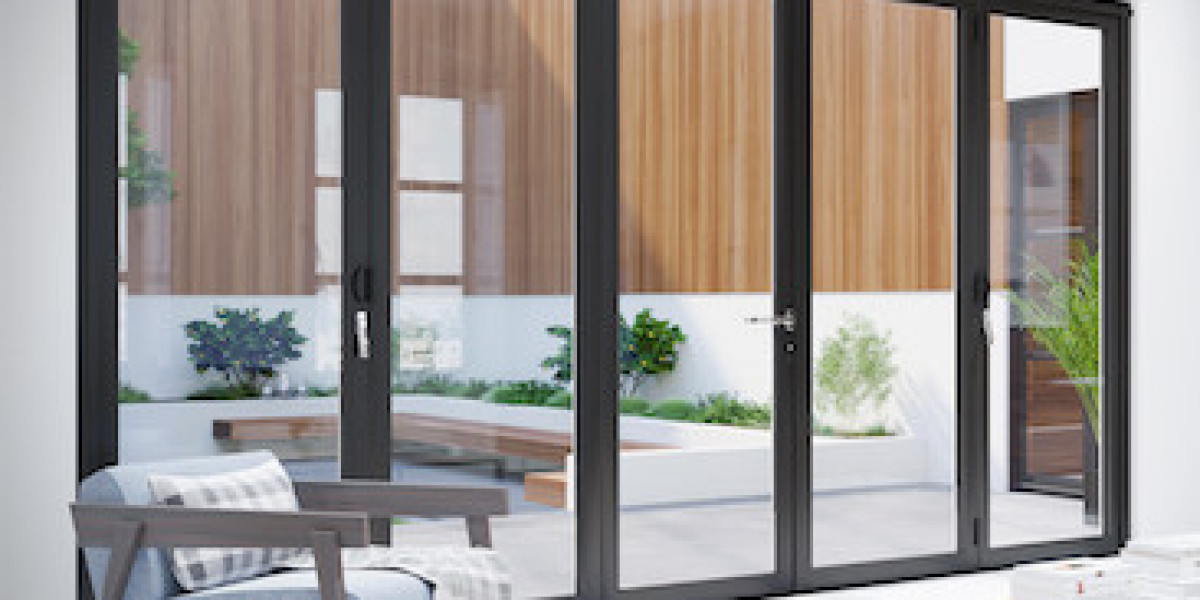
Restoring Smooth Operation: A Comprehensive Guide to Repairing Your Bifold Door Top Pivot
bifold door repair cost doors, likewise referred to as folding doors, are a popular option for making the most of area and creating a seamless transition in between rooms or in between indoor and outside living locations. Their unique folding mechanism permits broader openings than traditional hinged doors, making them ideal for closets, kitchens, utility room, and even as patio doors. However, the smooth and efficient operation of a bifold door depends upon numerous essential components, and among the most vital, yet typically overlooked, is the top pivot.

The top pivot is a small however important mechanism that sits at the leading corner of a bifold door panel, enabling it to turn efficiently within the track system. Gradually, due to wear and tear, incorrect positioning, and even unexpected damage, this pivot can stop working. A malfunctioning top pivot can lead to a host of frustrating issues, from sticking doors and loud operation to finish immobility. Fortunately, fixing or replacing a bifold door top pivot is frequently a workable DIY job, saving you the expense of professional repairs and restoring the functionality of your door.
This comprehensive guide will stroll you through the process of understanding, diagnosing, and fixing a bifold door leading pivot. We will check out the elements involved, determine typical problems, equip you with the essential tools and materials, and provide a detailed repair process. Whether you are an experienced DIY lover or a homeowner tackling home repairs for the very first time, this post will empower you to with confidence attend to a faulty bifold door top pivot and get your door operating efficiently when again.
Understanding the Top Pivot System
Before diving into the repair procedure, it's helpful to understand the function of the leading pivot within the more comprehensive bifold door system. The leading pivot, in combination with the bottom pivot (typically referred to as a guide or wheel), works to manage the movement and stability of each door panel.
Usually, a bifold door system includes:
- Top Track: A metal track set up horizontally at the top of the door opening. This track houses the leading pivots and guides the door panel's motion.
- Bottom Track or Guide: Some bifold door systems use a bottom track, while others use a bottom guide that is either a pin or a wheel, connecting with a groove or channel on the floor or door jamb. This bottom element assists support the door panel and maintains alignment.
- Leading Pivots: These are small, normally plastic or metal elements that are inserted into the top edge of the door panel and trip within the leading track. They enable the door panel to pivot and slide smoothly along the track.
- Connecting Hinges: Hinges that connect the private door panels together, allowing them to fold in a concertina design.
- Door Handles and Hardware: Hardware used for operating and protecting the bifold door.
The leading pivot bears a significant load, assisting in the smooth gliding and folding action of the door. It requires to be robust enough to withstand consistent usage, yet accurate enough to enable effortless movement. Comprehending its function helps in appreciating why its proper function is so crucial to the total operation of the bifold door.
Identifying Common Top Pivot Problems
Recognizing the signs of a failing leading pivot is the primary step towards a successful repair. Here are some typical indications that suggest a problem with your bifold door's top pivot:
- Sticking or Jerky Door Movement: The door becomes hard to open or close smoothly, being reluctant or capturing as it moves along the track. This is often the most obvious symptom.
- Noisy Operation: You may hear grinding, squeaking, or clicking sounds as the door is operated, suggesting friction or damage within the pivot system or track.
- Door Panel Drooping or Sagging: If the leading pivot is used or broken, the door panel may sag a little at the top, causing misalignment and further hindering smooth operation.
- Visible Damage to the Pivot: Upon evaluation, you might be able to see cracks, chips, or breaks in the plastic or metal parts of the top pivot itself.
- Door Jumping Out of the Track: In severe cases of pivot failure, the door panel might leap out of the leading track completely, becoming totally inoperable and possibly damaging the door or frame.
- Increased Effort to Operate: If you find yourself needing to exert more force than usual to open or close the door, it might be an indication of increased friction due to a stopping working pivot.
If you observe any of these symptoms, it is highly likely that your bifold door Restoration door's top pivot needs attention. Ignoring these issues can result in additional damage to the door, track, or surrounding frame, making the repair more complex and pricey in the long run.
Tools and Materials You'll Need
Before you start the repair, collect the required tools and materials to guarantee a smooth and effective procedure. Having actually everything prepared ahead of time will conserve you time and disappointment.
Tools:
- Screwdriver Set: A Phillips head and flathead screwdriver will be necessary for removing and installing screws associated with the pivot and door hardware. Ensure you have numerous sizes to fit different screws.
- Pliers: Pliers can be helpful for gripping and maneuvering little parts, especially if the old pivot is stuck or hard to eliminate.
- Hammer (Optional): A light-weight hammer may be needed to carefully tap the brand-new pivot into location, if needed by the design.
- Measuring Tape: To make sure accurate placement and positioning when installing the brand-new pivot.
- Pencil or Marker: For marking positions and guaranteeing proper alignment.
- Shatterproof glass: Protecting your eyes is essential when working with tools and hardware.
- Gloves (Optional): To secure your hands and offer better grip.
Products:
- Replacement Top Pivot: This is the most essential material. It's important to buy a replacement pivot that works with your particular bifold door system. Take the old pivot with you to the hardware store for contrast, or note down the door producer and design if possible. Top pivots can be found in numerous sizes and designs.
- Lube (Silicone Spray or Dry Graphite): Lubricating the track and new pivot will make sure smooth, quiet operation and prolong the life of the pivot.
- Wood Filler or Wood Glue (Optional): If the screw holes holding the pivot in location are removed or damaged, wood filler or glue may be needed to reinforce them.
- New Screws (Optional): If the existing screws are harmed or removed, have a set of replacement screws of the proper size and type on hand.
Step-by-Step Guide to Repairing the Top Pivot
With your tools and materials ready, you can now proceed with the repair. Follow these step-by-step instructions thoroughly:
Step 1: Safety and Preparation
- Place on your safety glasses.
- Guarantee the work location is clear and well-lit.
- Collect all your tools and materials and position them within simple reach.
Action 2: Inspect and Access the Top Pivot
- Carefully take a look at the top pivot of the bothersome door panel to visually evaluate the damage. Search for fractures, breaks, or indications of wear.
- Figure out how the pivot is connected to the door. Most are typically kept in place by screws.
- You might require to somewhat open or close the bifold door to acquire much better access to the top pivot.
Action 3: Remove the Old Top Pivot
- Using the appropriate screwdriver (usually Phillips head), carefully eliminate the screws securing the top pivot to the door panel.
- If the screws are stripped or challenging to remove, you may need to utilize pliers to grip the screw head and gently turn it. Prevent damaging the surrounding door material.
- Once the screws are gotten rid of, gently take out the old leading pivot. If it's stuck, utilize pliers to gently wiggle and pull it complimentary.
Step 4: Prepare for the New Pivot (If Necessary)
- Inspect Screw Holes: Examine the screw holes in the door where the pivot was connected. If they are stripped or enlarged, you might require to enhance them.
- For Minor Stripping: Apply a percentage of wood glue into the screw hole and let it partly dry for a few minutes. This will offer the screws a better grip.
- For Severely Stripped Holes: Use wood filler to fill the removed holes completely. Enable the filler to dry and harden according to the item instructions. When dry, pre-drill pilot holes slightly smaller than the brand-new screws to ensure a safe accessory.
Step 5: Install the New Top Pivot
- Position the brand-new leading pivot in the same orientation as the old one was removed.
- Line up the screw holes of the new pivot with the holes in the door panel.
- Insert the screws and tighten them safely with the screwdriver. Prevent overtightening, which could remove the screw holes or harm the pivot. Guarantee the pivot is securely attached however not exceedingly tight.
Action 6: Lubricate the Track and Pivot
- Use a little quantity of silicone spray or dry graphite lube to the top track of the bifold door, concentrating on the area where the leading pivot will run.
- Likewise, lightly oil the moving parts of the new top pivot itself. This will promote smooth operation and lower friction.
Step 7: Test and Adjust
- Thoroughly operate the bifold door, opening and closing it numerous times.
- Look for smooth, peaceful movement. If the door still sticks or binds, re-inspect the pivot for appropriate installation and alignment.
- Make sure the door panels fold and unfold properly and that the door is not rubbing versus the frame or track.
- If essential, small adjustments to the pivot position or track alignment might be needed. Consult your bifold door producer's instructions for specific modification procedures if provided.
Step 8: Clean Up
- Once you are satisfied with the door's operation, tidy up your workspace and put away your tools.
Repairing Common Issues
While fixing a leading pivot is frequently simple, you might come across some challenges. Here are a few repairing ideas:
- Pivot Doesn't Fit: If the new pivot doesn't suit the track or door, double-check that you have the correct replacement type. Compare it carefully to the old pivot and the door specs.
- Screws Won't Tighten: Stripped screw holes are a common concern. Refer back to Step 4 and utilize wood filler or glue to strengthen the holes before trying to tighten the screws once again.
- Door Still Sticks After Pivot Replacement: If the door still does not run smoothly after changing the pivot, the issue may lie elsewhere. Examine the bottom pivot/guide, the track for debris or damage, or the door panel hinges for stiffness.
- Door Panel Misalignment: If the door panels are not aligned properly after repair, ensure the top pivot is effectively seated in the track and that the door panel is correctly positioned within the frame. Look for any warping or damage to the door panel itself.
Keeping Your Bifold Door Pivots
Preventative maintenance can significantly lengthen the life expectancy of your bifold door pivots and decrease the requirement for regular repairs. Here are some helpful upkeep ideas:
- Regular Lubrication: Lubricate the leading track and pivots with silicone spray or dry graphite every few months to lower friction and wear.
- Keep Tracks Clean: Periodically clean the top and bottom tracks to remove dust, dirt, and particles that can hamper smooth operation. Utilize a vacuum cleaner or a brush to clean the tracks.
- Examine Regularly: Inspect the leading and bottom pivots frequently for signs of wear, damage, or looseness. Attend to any small concerns promptly before they intensify.
- Prevent Slamming: Avoid knocking the bifold doors, as this can put unnecessary tension on the pivots and hardware, resulting in premature failure.
- Check Alignment: Periodically examine the alignment of the door panels to ensure they are folding and unfolding properly which there is no unnecessary stress on the pivots.
When to Call a Professional
While DIY repair is often possible, there are scenarios where seeking expert assistance is recommended. Consider calling a door repair expert if:
- You are unpleasant with DIY repairs.
- The damage to the door or frame is substantial beyond just the pivot.
- You are unable to identify the correct replacement pivot.
- You encounter persistent issues after trying the repair.
- The bifold door is part of a complicated system, such as a multi-panel patio door, and requires specialized understanding.
An expert door specialist has the experience and competence to accurately identify complex fix bifold door hardware door problems and carry out repairs efficiently and effectively.
Repairing a bifold door top pivot is a gratifying DIY job that can bring back the smooth and uncomplicated operation of your door. By comprehending the components, identifying the issue, and following the step-by-step guide detailed in this article, you can confidently tackle this repair and conserve yourself time and money. Regular upkeep and prompt attention to minor problems will make sure the durability and trustworthy performance of your bifold doors for years to come, contributing to the convenience and functionality of your living space.
Regularly Asked Questions (FAQs) about Bifold Door Top Pivot Repair
Q1: How do I know what kind of leading pivot to buy as a replacement?
A: The best way is to get rid of the old pivot and take it with you to a hardware shop. Compare it visually to the offered choices, paying attention to the size, shape, and accessory technique. Additionally, if you understand the producer and model of your bifold door, you might be able to find particular replacement parts online or through the producer.
Q2: Can I repair a damaged leading pivot, or do I always need to replace it?
A: In many cases, it's more useful and trustworthy to replace a broken or used leading pivot rather than trying to repair it. Pivots are relatively inexpensive, and replacement guarantees correct function and longevity. Trying to repair a broken pivot may lead to more issues and is normally not suggested.
Q3: My screws are stripped and will not hold the new pivot. What can I do?
A: Stripped screw holes prevail. Try utilizing somewhat longer or thicker screws. If that doesn't work, use wood glue into the screw hole and let it partly dry before re-screwing. For badly removed holes, utilize wood filler to fill them entirely, let it dry, and then pre-drill pilot holes for the brand-new screws.
Q4: Do I require to get rid of the whole sliding bifold door repair door to replace the leading pivot?
A: Often, you can replace the leading pivot without fully removing the door panel. However, depending on the style and availability, it might be easier to partly remove the door panel to get much better access. In many cases, particularly with much heavier doors or complex systems, eliminating the door panel may be more secure and more hassle-free.
Q5: After replacing the top pivot, my door is still tough to open. What else could be wrong?
A: If the problem persists after pivot replacement, check other possible problems:
- Bottom pivot/guide: Inspect for damage or particles.
- Track: Clean and oil the top and bottom tracks. Examine for damage or obstructions.
- Hinges: Ensure the door panel hinges are not stiff or binding. Oil them if necessary.
- Door Alignment: Check if the door panels are effectively lined up within the frame.
Q6: How typically should I oil my bifold door rotates?
A: Regular lubrication every 3-6 months is advised for ideal efficiency. More frequent lubrication may be required in dirty or high-use environments. Use silicone spray or dry graphite lubricant to keep the pivots and track moving smoothly.







